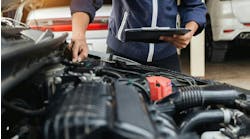The same notion applies to research and development. Engineers look at available technology and extrapolate what can be done with it. They make plans and devise inventions. They set goals and timelines. They make announcements. The market hurries up and waits, preparing for new products that often arrive late or in a form very different than the one originally intended.
This is pretty much what has happened with by-wire and electric steering technology. Just several years ago, industry forecasters confidently predicted by-wire technology would be featured in production vehicles by 2005 with an array of electric systems also taking a big chunk of the American market by that time. Neither has happened.
That doesn’t mean, however, these systems won’t arrive. They’re very much on their way and should be showing up in your shop within the next few years (unless things change again!) if they haven’t already. Until then, make proper use of this extra wait time by brushing up your knowledge of how these systems do or will function.
What happened to by-wire technology?
During the 50 years they’ve been in production, power steering systems have performed admirably. Like any piece of technology, they too eventually become obsolete. The main problem with these systems involves vehicle efficiency. Hydraulic systems, with their hoses, belts, pulleys, heavy mechanical pieces and fluid, weigh vehicles down and sap engine efficiency. Because they’re also powered by the vehicle engine, they tap even more energy from a vehicle. They also use toxic fluids and require bulky structures that use up critical vehicle space and limit vehicle design possibilities.
The goal of auto engineers for the past 15 years has been to replace these mechanical systems with by-wire arrangements, which transmit driver input directly to the wheels via electronic commands (the basic concept at work in video driving games). As the 21st Century opened, it seemed inevitable that a production vehicle with by-wire steering would be made available. BMW, in fact, was poised to be the manufacturer of that vehicle just several years ago.
Elsewhere, other issues have slowed the deployment of by-wire systems. In an interview with ABRN, John Wilkerson, spokesman for TRW, noted that most vehicles still need to implement the 42 volt electrical systems required for by-wire technology. General Motors Corp., in fact, has tied the development of by-wire steering to its alternate fuel vehicles (most notably the Hywire) since these vehicles will use higher current electrical systems regardless.
Finally, by-wire technology raises a number of safety concerns. Mainly, if the electric current fails, the steering shuts off. Wilkerson says this factor creates a need for a reliable electric backup system, which still needs to be developed. Some auto engineers also recommend redundant systems, such as dual control units, two independent wiring harnesses and a mechanical linkage, to guide the car in the event of a total electrical systems failure. Wilkerson expects manufacturers to resolve all these problems and says by-wire vehicles should hit the streets by 2010.
In the meantime, migratory systems such as partial or fulltime electronic steering are helping engineers work out design issues, and they’re preparing consumers for the day when their steering commands will hang by a wire.
Halfway home with hybrids
Hybrid steering systems, which typically feature a separate electric motor to operate the hydraulic system, are popular since they feature available hydraulic technology. This helps make them an affordable option for manufacturers and consumers. Besides cost, their ability to move heavier, full sized vehicles gives them an advantage over electric power steering (EPS) systems which often cannot. Recently developed hybrid systems also can provide steering enhancements that benefit maneuverability and safety.
BMW selected just such a system for its 2004 5-series when it utilized Active Steering, a product of the partnership between German engineering giants Bosch and ZF Friedrichshafen (Bosch-ZF). Active Steering automatically changes steering gear ratios to supply optimal steering for different driving scenarios.
Active Steering uses a specially designed planetary gear train that blends mechanical and electrical steering commands. At the upper end of this train is a sun gear that reasponds to steering wheel motion. When this gear moves, it simultaneously turns three planet gears that drive a second sun gear attached to the pinion shaft. Attached to the train are an electric motor and an electromagnetic locking unit (which restores mechanical steering in the event of a power failure). Controlling this entire setup is an electronic control unit (ECU) that also gathers operating information—for example, road speed, individual wheel speed, steering wheel angle and pinion angle.
When the ECU senses a specific pre-programmed driving environment, it instructs the electromagnetic locking unit to release and orders the electric motor to spin the planetary gear set’s carrier. Active Steering is thus started.
Following commands from the ECU, Active Steering speeds up or slows down the steering ratio independent of steering input (without impeding driver effort). Active Steering automatically changes steering ratios relative to changes in the steering-wheel angle input and vehicle speed. At low speeds, it can provide a 10:1 ratio that produces high maneuverability for parking in tight spaces. At highway speeds, the ratio increases to 20:1 (compared to 14:1 on a conventional system) for a smoother ride.
The system also can be tuned to prevent skidding. BMW engineers noted that when Active Steering changed the steering ratio during turns, it also changed the front axle steering angle. Building on this function, BMW added emergency steering inputs that apply up to 2.5 degrees of countersteer in turns to avoid skids. Bosch-ZF says Active Steering thwarts skids four times faster than brake-based stability systems and makes spinning out the 5-series a practical impossibility.
Bosch-ZF plans to make Active Steering products for similar high-end cars (since cost makes them prohibitive for less expensive vehicles). Other manufacturers also have gotten into the hybrid act. TRW makes engine-independent electro-hydraulic power steering (EHPS) systems. (TRW actually made the first hybrid system in the 1980’s when it developed a setup with an electric motor to drive the hydraulic power steering pump on the Pontiac Fiero.) Most of these products have been limited to overseas use. With the introduction of Active Steering on the 5-series, this could change.
Also possibly changing—what’s particularly significant—is the attitude towards non-traditional steering systems. Active Steering puts a form of electric steering in the hands of consumers. That could go a long way in getting them, other automakers and insurers confortable with using new steering technology.
The full-time electric answer
Looking beyond hybrid technology, fulltime EPS systems offer the next step to by-wire. These systems actually have been hard at work in some vehicles for more than a decade.
In 1993, Acura installed EPS on its NSX. Honda installed EPS on the S2000 sports car, along with its hybrid Insight and Civic sedan. Saturn includes EPS on its VUE SUV and Ion sedan. GM EPS models include the Malibu (beginning in 2004), which features Delphi’s E*STEER unit, and large trucks fitted with Delphi’s QuadraSteer four-wheel steering product. QuadraSteer utilizes a hydraulic front axle system and EPS on the rear. BMW’s latest 3-series will include a similar setup, with rear-wheel steering controlled by a Continental-designed EPS system. Bosch-ZF has been fitting European automobiles (including the VW Golf, BMW Z4, Audi A3 and VW Touran) with its Servolectric system since 1999.
All of these systems essentially function the same way. Most feature a series of sensors along the steering rack. One sensor monitors driver input from the steering wheel. The other monitors the steering gear position and transmits feedback on correct operation to a steering module (additional sensors can be added to input vehicle speed, lateral acceleration, etc.). Whenever the wheel is turned, the steering module sends power to an electric motor that in turn moves the steering gear.
For safety considerations, the electric steering unit remains connected to the steering wheel by a steel shaft. If the steering module senses a problem, it shuts off the electric motor, allowing the steel shaft to steer the vehicle.
Because these systems rely on electronic modules and can tie into computers, diagnosing problems (for example collision damage) theoretically should be easier than doing the same on a traditional hydraulic system. Saturn already has very specific, clear diagnosis and repair guidelines. That’s good news for shops, especially those that currently outsource steering work. With EPS systems trickling into the U.S. market, more shops should see these systems sooner rather than later.
Steering forecast
How will the U.S. steering market change in the next five years? It’s still difficult to say. When automakers implement new technology, they tend to do so by model instead of altering complete product lines. Even then, next generation technology usually doesn’t get featured on a model unless it’s new (like the Saturn VUE and Ion) or is undergoing a thorough design change (like the BMW 3- and 5-series). The reason here—it makes far more economic sense for automakers to stick with available designs and parts as long as possible before investing money in new machining.
Wilkerson points out that TRW still gets more orders for traditional and EPHS systems than EPS systems. When new steering technology does take market share, expect it to do so in slices, one model line at a time.
Faced with this challenge, steering makers still have managed to produce some forecasts. They all agree demand for EPS will increase. Where and at what level this increase will occur is debatable.
Delphi sees worldwide adoption rates of EPS reaching 20 percent of the light vehicle market by 2007. TRW’s more aggressive forecast calls for 50 percent of all new cars to incorporate some form of electrical steering assistance by 2010. In either case, a large chunk of the market will be left untouched for a time.
Progressive acceptance and adoption of these systems can only mean one thing. A lot of repairers and motorists will continue to hurry up and wait before getting their hands on this developing technology.


